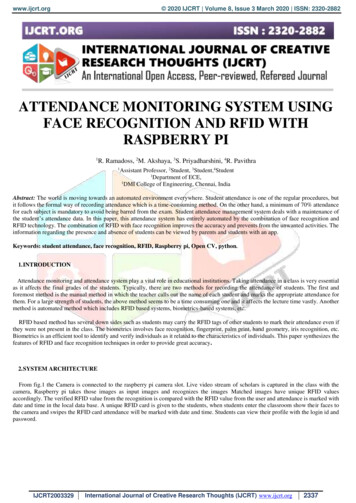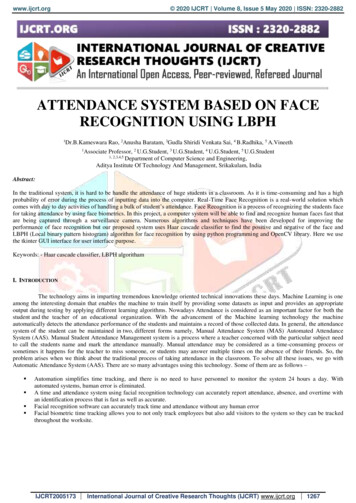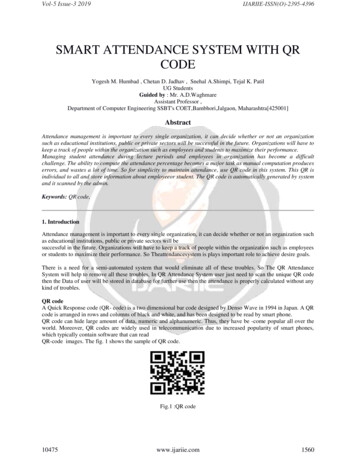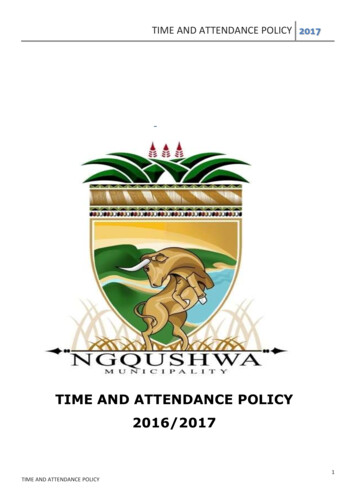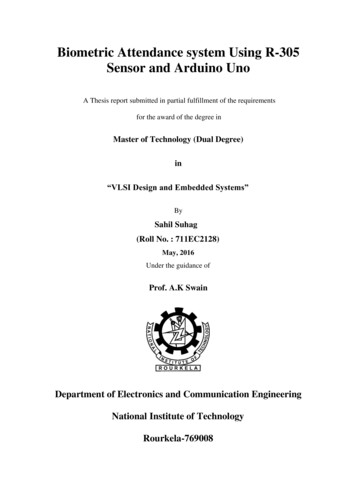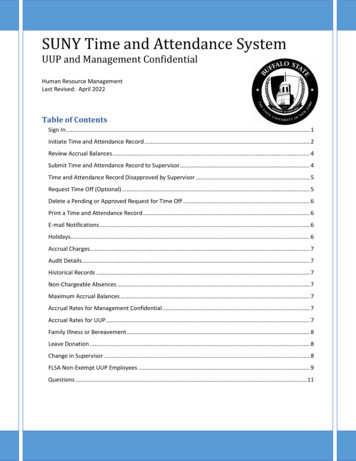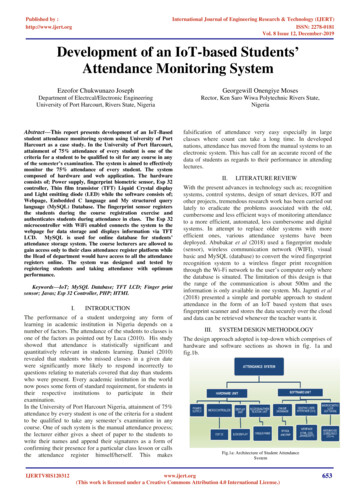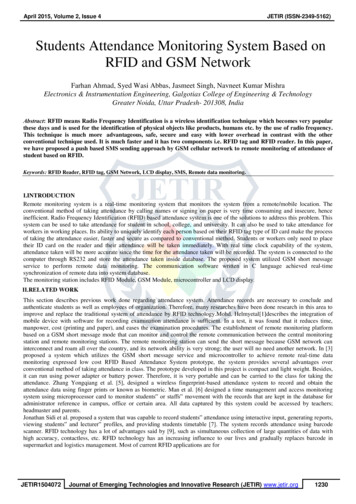
Transcription
April 2015, Volume 2, Issue 4JETIR (ISSN-2349-5162)Students Attendance Monitoring System Based onRFID and GSM NetworkFarhan Ahmad, Syed Wasi Abbas, Jasmeet Singh, Navneet Kumar MishraElectronics & Instrumentation Engineering, Galgotias College of Engineering & TechnologyGreater Noida, Uttar Pradesh- 201308, IndiaAbstract: RFID means Radio Frequency Identification is a wireless identification technique which becomes very popularthese days and is used for the identification of physical objects like products, humans etc. by the use of radio frequency.This technique is much more advantageous, safe, secure and easy with lower overhead in contrast with the otherconventional technique used. It is much faster and it has two components i.e. RFID tag and RFID reader. In this paper,we have proposed a push based SMS sending approach by GSM cellular network to remote monitoring of attendance ofstudent based on RFID.Keywords: RFID Reader, RFID tag, GSM Network, LCD display, SMS, Remote data monitoring.I.INTRODUCTIONRemote monitoring system is a real-time monitoring system that monitors the system from a remote/mobile location. Theconventional method of taking attendance by calling names or signing on paper is very time consuming and insecure, henceinefficient. Radio Frequency Identification (RFID) based attendance system is one of the solutions to address this problem. Thissystem can be used to take attendance for student in school, college, and university. It can also be used to take attendance forworkers in working places. Its ability to uniquely identify each person based on their RFID tag type of ID card make the processof taking the attendance easier, faster and secure as compared to conventional method. Students or workers only need to placetheir ID card on the reader and their attendance will be taken immediately. With real time clock capability of the system,attendance taken will be more accurate since the time for the attendance taken will be recorded. The system is connected to thecomputer through RS232 and store the attendance taken inside database. The proposed system utilized GSM short messageservice to perform remote data monitoring. The communication software written in C language achieved real-timesynchronization of remote data into system database.The monitoring station includes RFID Module, GSM Module, microcontroller and LCD display.II.RELATED WORKThis section describes previous work done regarding attendance system. Attendance records are necessary to conclude andauthenticate students as well as employees of organization. Therefore, many researches have been done research in this area toimprove and replace the traditional system of attendance by RFID technology.Mohd. Helmyetal[1]describes the integration ofmobile device with software for recording examination attendance is sufficient. In a test, it was found that it reduces time,manpower, cost (printing and paper), and eases the examination procedures. The establishment of remote monitoring platformbased on a GSM short message mode that can monitor and control the remote communication between the central monitoringstation and remote monitoring stations. The remote monitoring station can send the short message because GSM network caninterconnect and roam all over the country, and its network ability is very strong; the user will no need another network. In [3]proposed a system which utilizes the GSM short message service and microcontroller to achieve remote real-time datamonitoring expressed low cost RFID Based Attendance System prototype, the system provides several advantages overconventional method of taking attendance in class. The prototype developed in this project is compact and light weight. Besides,it can run using power adapter or battery power. Therefore, it is very portable and can be carried to the class for taking theattendance. Zhang Yongqiang et al. [5], designed a wireless fingerprint-based attendance system to record and obtain theattendance data using finger prints or known as biometric. Man et al. [6] designed a time management and access monitoringsystem using microprocessor card to monitor students‟ or staffs‟ movement with the records that are kept in the database foradministrator reference in campus, office or certain area. All data captured by this system could be accessed by teachers;headmaster and parents.Jonathan Sidi et al. proposed a system that was capable to record students‟ attendance using interactive input, generating reports,viewing students‟ and lecturer‟ profiles, and providing students timetable [7]. The system records attendance using barcodescanner. RFID technology has a lot of advantages said by [9], such as simultaneous collection of large quantities of data withhigh accuracy, contactless, etc. RFID technology has an increasing influence to our lives and gradually replaces barcode insupermarket and logistics management. Most of current RFID applications are forJETIR1504072Journal of Emerging Technologies and Innovative Research (JETIR) www.jetir.org1230
April 2015, Volume 2, Issue 4JETIR (ISSN-2349-5162)access control and goods location tracking. In fact, RFID provides the function of individual goods identification and onlinechangeable data storage. We should make a better utility to these additional functions. They expect that the next generation ofRFID applications should incorporate intelligent. Intelligent RFID applications could bring in new research and commercialopportunities. Moreover, it helps to further reduce costs, enhance customer services and could provide insight for updatingbusiness models. The establishment of remote monitoring platform based on a GSM [10] short message mode that can monitorand control the remote communication between the central monitoring station and remote monitoring stations. The Centralmonitoring station can receive the monitoring data of remote monitoring stations and stores them in the database. The remotemonitoring station can send the short message in time or timing through the keyboard operation, and it can receive the settingcommand from the central monitoring station and complete the setting operation. Because GSM network can interconnect androam all over the country, and its network ability is very strong, the user will no need another network. The system can improvethe network coverage for customers greatly, and it not only can save expensive network building cost and maintenance costs butalso the user number is not limited. There are three important essential factors to consider, (1) knowing RFID feature, (2) processredesigned and construction of environment, (3) information technology uses. Know RFID features to avoid the troubles. Forexample, there are many tags under the reader. That will result in collision. But we just constructed a build space and deign newprocesses to avoid it. In this paper, we wanted to initial a concept of RFID strategy and deployment. Do not focus on the RFIDhardware. It is important to consider a suitable approach for the business, when implementation of RFID. Although it is success inthis practical case, but there are many problems in the running. For example, if the reader didn't detect the tags. If the tags failure.What should we do? How to tackle in the management is a real thing. In, authors presented an automatic, digital, intelligent andscientific integrated management information system by using RFID-based system. It provides a valuable service to theequipment departments with safe and high-quality management through the systemized process of equipment management andmaintenance.The application of RFID and digital certificate help us to reduce human errors. Ultimately, it can basically solve the problems inthe traditional system and increase the efficiency of equipment management and maintenance. In the regard of security andefficiency, the REMIS is an effective solution for automatic management system using RFID and digital certification. The RFIDtechnology enables the management processes more rapidly and conveniently .authors describes remote monitoring oftemperature and humidity system as the Phillips core LPC2148 controller in order to achieve high-quality environment, collectsthe temperature and humidity by receiving and sending short messages and man-machine interface. It can monitor remotely onsite temperature and humidity which the system receives instructions and uploads real-time information between GSM moduleSiemens SIM 900 and monitoring center station. Developing RFID-enabled application for handling RFID data in real-time atpoint of action without integrated software platform is a very time consuming effort. Among all RFID-enabled applications,there exists some common functionality that can be included in the integrated software platform to simplify the applicationdevelopment and reduce the development time as well as cost. The common features in the integrated software platform maycontinue to evolve as more application developed and more experience gained. Using an integrated software platform to developRFID-enabled applications would easier to justify the investment via implementation cost reduction and new benefit realization.It is a critical approach to accelerate the future RFID adoptions as the applications of technology are still emerging. The systemaims at establishing remote monitoring platform based on a GSM short message mode that can monitor and control the remotecommunication between the central monitoring station and remote monitoring stations [10]. The Central monitoring station canreceive the monitoring data of remote monitoring stations and stores them in the database, and also can call and print then at anytime. At the same time, the system can on-line monitor the status of the remote monitored object, and it can send settingcommands to the remote monitoring station by the mode of sending short messages. Remote monitoring station can be able tosend the measured data dealt with by the MCU of the monitored object and send them to central monitoring station by the modeof the short message. The remote monitoring station can send the short message in time or timing through the keyboardoperation, and it can receive the setting command from the central monitoring station and complete the setting operation.Because GSM network can interconnect and roam all over the country, and its network ability is very strong, the user will noneed another network. The system can improve the network coverage for customers greatly, and it not only can save expensivenetwork building cost and maintenance costs but also the user number is not limited.III.HARDWARE STRUCTURE OF REMOTE MONITORING SYSTEMThe system hardware includes RFID Reader, SIM 900A GSM module with Antenna, Connecting wires, SIM Card, Power Supply.Figure 1: structure of remote monitoring systemJETIR1504072Journal of Emerging Technologies and Innovative Research (JETIR) www.jetir.org1231
April 2015, Volume 2, Issue 4JETIR (ISSN-2349-5162)Fig. circuit diagram of proposed systemIV.RFID CHARACTERISTICSRadio frequency waves are the waves whose frequency band lies in the range of 3 KHz to 300 GHz, thus it is a wireless techniqueof identifying objects. It uses electrostatic and electromagnetic coupling and a variety of modulation and encoding techniquesbetween chip and the reader for transferring the data. Electrostatic refers to the phenomena of static (without acceleration) electriccharges. Modulation is defined as the technique of transferring the data to longer distance by introducing the carrier wave to themodulating wave. Encoding is defined as converting the data from one suitable form to another suitable form. Various encodingschemes are Polar form, Non-Polar form, NRZ encoding, Manchester encoding, etc. There are two components in RFID systemand that are explained as below:1. RFID Tag is an IC chip that has unique hexadecimal or electronic product code (EPC) contained in it. Here “UNIQUE‟refers that each and every code word of the tag is independent of other code word. The tag acts as a key that is capable ofopening a particular lock. So, it is also named as RFID key. The tag is classified into 2 categories: Active tags and Passive tags.Active tags are active in nature i.e. they do not require any external source, they have their own in-built battery. It can transmithigh frequencies so it can be detectable to a longer range.Passive tags are passive in nature i.e. they do not have any battery source built in them. They transmit low frequencies so theyare detectable up to few meters of distance.Figure 2: RFID Tag/KeyJETIR1504072Journal of Emerging Technologies and Innovative Research (JETIR) www.jetir.org1232
April 2015, Volume 2, Issue 4JETIR (ISSN-2349-5162)2. RFID Reader is a system which transmits and receives the data to the tag or key by radio waves.Figure 3: RFID ReaderV.GSM CHARACTERISTICSGlobal System for Mobile communications [8] (GSM) is an international standard for mobile communication. Originally, theacronym GSM stood for Groupe Spécial Mobile, a group formed by the Conference of European Posts and Telegraphs (CEPT)in 1982 to research the merits of a European standard for mobile telecommunications. Commercial service using the GSMsystem did not actually start until 1991. Instead of using analog service, GSM was developed as a digital system using TDMAtechnology.Figure 4: GSM ArchitectureThe acknowledgement is based on GSM short messages from cell phones, and the equipment used is SIM 300, is an industrial GSM modulewhich provides four transmission modes including voice, data, short message, and FAX. It works in frequency band GSM 900MHZ or I800MHZ, power voltage 3.4V to 4.5V and baud rate is 300 bps to 115 kbps, where 1200-115 kbps is automatically configured.Short Message Service (SMS) is a text messaging service component of phone, web, or mobile communication systems, using standardizedcommunications protocols that allow the exchange of short text messages between fixed line or mobile phone devices. SMS text messaging isthe most widely used data application in the world, with 2.4 billion active users, or 74% of all mobile phone subscribers. To communicate withan SMSC, an SMSC protocol is required. Most of these SMSC protocols are proprietary to the company that developed the SMSC. One widelyused SMSC protocol is SMPP (Short Message Peer to Peer). It was originally a proprietary SMSC protocol created by Logica (an SMSCvendor). Now SMPP is an open SMSC protocol whose development is controlled by a non-profitable organization SMS Forum.AT command sets are used in data transmission, and the transmission rate is 2400bps, 4800bps, 9600bps, or 14400bps. SIM 900 provides astandard RS232 interface. The serial interface of SIM 900 is directly connected to the serial interface wtih LCD display using Microcontroller.VI.SOFTWARE STRUCTURE OF REMOTE MONITORING SYSTEMThe text mode is chosen for the transmission of SMS. AT commands are used here for the communication purpose.AT CMGF 1: for the selection of text mode of SMS.AT CMGS ”mobile number”: used to send the message on the given mobile number .JETIR1504072Journal of Emerging Technologies and Innovative Research (JETIR) www.jetir.org1233
April 2015, Volume 2, Issue 4JETIR (ISSN-2349-5162)VII.PROGRAM AND DATABASEDatabase is the backbone of the system because it is having all the data fields like ID, Name, Mobile Number, Password and the attendance.Cprogramming is used by using the software KIEL which is further burned into microcontroller ATmega16 .The RFID data is send to the systemand then it will match with the database if it exists then the success message is shows else new records add/update button will appear andcorrespondingly the record is added and SMS will be sent.VIII.CONCLUSIONThe designed system provides an acknowledgement to the client whose attendance has been taken. It also describes the total sum of attendancethat is done by the client. There is a lot of benefits of the system i.e. students attendance record to the parents on daily basis, student’sattendance notification as they punch: reduces the overhead in the compilation of attendance at the end of the month also the student know thathow much percentage of attendance he will get as he/she knows the total classes he/she attend.With the help of this proposed model, one can easilymonitor data from any remote location via SMS, there is no need of direct contact, internet or any kind of request send by user as it is pushbased technique.Fig. 9 The final picture of our projectFig.10 Attendance received by the parent on mobileREFERENCES[1] Daniel M. Dobkin and Steven M. Weigand,” Environmental effects on RFID tag antennas”, California: Bulis Press, 2010.[2] Amirjan Bin Nawabjan,”Automated attendance management software”, University of Technology, Malaysia: DegreeThesis,2009JETIR1504072Journal of Emerging Technologies and Innovative Research (JETIR) www.jetir.org1234
April 2015, Volume 2, Issue 4JETIR (ISSN-2349-5162)[3] Gordon .N. Withtaker,”Introduction to biometrics technology”, Dint and sons Limited,2002[4] http://www.theregister.co.uk/2004/10/14/human rfid implants[5] Mary Catherine O'Connor,” Sun Microsystems Piloting RFID Tagging for Financial Customers”, USA: Preston Press,2009.[6] Markus Hansen and Sebastian Meissner,” Identification and Tracking of Individuals and Social Networks using the ElectronicProduct Code on RFID Tas”, Volume 262, 2008, pp 143-150, 2000.[7] Prof. Y. B. Thakare, Prof. S.S. Musale, Prof. S.R. Ganorkar, ―A Technological Review of RFID & Applications, IETInternational Conference on Wireless, Mobile and Multimedia Networks, pp.65-70, January 2008[8] Klaus Finkenzeller, RFID Hand Book: Fundamental and Applications in Contactless Smart Cards and Identification, SecondEdition, Wiley, 2002.[9] Nurbek Saparkhojayev1 and Selim Guvercin” Attendance Control System based on RFID-technology”, IJCSI InternationalJournal of Computer Science Issues, Vol. 9, Issue 3, No 1, May 2001JETIR1504072Journal of Emerging Technologies and Innovative Research (JETIR) www.jetir.org1235
April 2015, Volume 2, Issue 4 JETIR (ISSN-2349-5162) JETIR1504072 Journal of Emerging Technologies and Innovative Research (JETIR) www.jetir.org 1230 Students Attendance Monitoring System Based on
